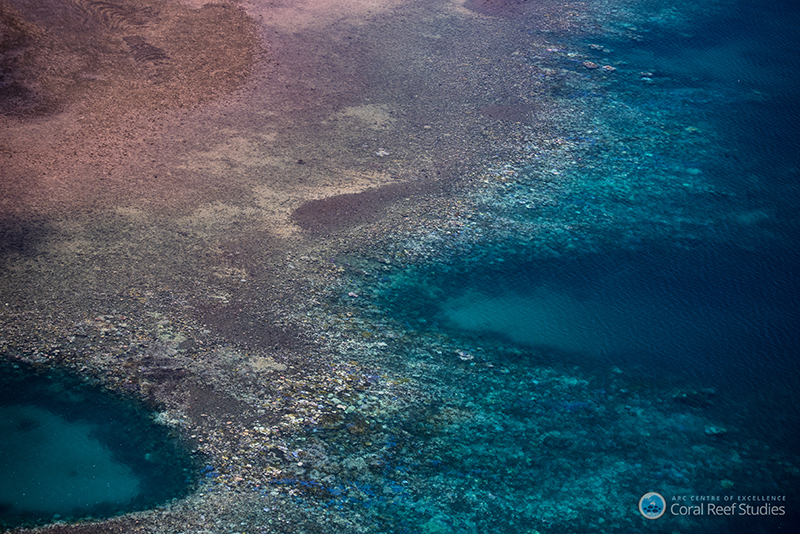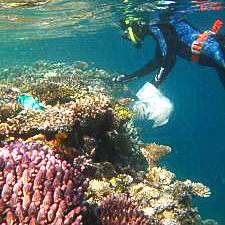Twice a year, climate scientist Kim Cobb travels to Christmas Island in the middle of the Pacific Ocean to collect core samples from coral reefs. The data help in reconstructing past climate records and improving predictions of future global warming. But when Cobb, a research scientist and professor at the Georgia Institute of Technology, arrived on the island earlier this month, she was stunned. The corals she had spent the past 18 years studying were largely dead or dying.
The scene has become a familiar one across the Pacific and Indian oceans this year as a record-breaking El Niño drove water temperatures high above normal and caused fragile coral reef systems to bleach from stress or die.

A reported 93 percent of the Great Barrier Reef has experienced bleaching, according to an extensive aerial survey by a team of Australian scientists. Researchers across the region are reporting similar catastrophes from Hawaii to India.
In an interview with Yale Environment 360, Cobb talked about the recent bleaching event, the race to make reefs more resilient to rising global temperatures, and how coral records could change the way scientists project short-term climate impacts for the coming decades.
“What you think reefs might be experiencing in 20 years, they’re experiencing now,” Cobb says. “It took a very large, record-breaking event to bring that to our doorstep, but it is something that you always knew was coming. It has also encouraged us to make sure we are using this event to the best scientific end possible, to understand what we can about the vulnerability of coral reefs, and what governs resilience.”
Yale Environment 360: Your research is in using coral samples to better understand and predict climate change. What can coral tell us about the past that other sources, like ice cores or rock formations, can’t?
Kim Cobb: Corals are really special for two reasons. One is that they grow in the deep tropics, and we have very few other geological archives to tell us about past ocean temperatures, despite the importance of the ocean in driving the entire climate system. Second is that we can generate data with monthly [resolution]. I can drill samples out of a coral skeleton and get you one estimate of ocean temperatures per month for any time period that I have a sample for.
‘Corals provide us an overview of past El Niño activity, and the strength and frequency of events back across millennia.’
e360: How does one actually go about obtaining coral records? What does it entail and where are the study sites that you go to?
Cobb: The samples that we recover from the modern reef, we recover by scuba diving with a very large hydraulic drill. The samples that we recover from the fossil reefs strewn around the beaches, deposited there above the water line by large storms or possibly tsunamis, we just walk across beaches and pick those samples up. That’s easier than drilling a coral reef underwater.
e360: You had mentioned that corals can give a really detailed record, down to the month. How far back can you go?
Cobb: You can go back as far as you have samples, and in the case of my study sites in the middle of the Pacific, we can go back 7,000 years. Not continuously, but we have samples that go back to that time frame. These provide us an overview of past El Niño activity, and the strength and frequency of events back across those millennia.
e360: Have coral records been incorporated into our current global climate models?
Cobb: The global climate models themselves just are a collection of physical equations for how mass and heat move in our climate system, and how they’re transferred. In that sense, corals haven’t really been incorporated into the climate models, but they have been used to test climate models, and that’s something that is a very important emergent field, the comparison of climate model simulations to known histories of climate as recorded in any geological archive — corals, tree rings, ice cores.
This is something that I believe represents the future of climate change research.
e360: It seems like such a critical thing, what is going to happen in the short term. One of the biggest challenges in getting people to care about climate change has been that most outlooks are long-term.
Cobb: Right. Everything is a hundred years. If you’re lucky, it’s fifty years. So this is the real frontier of climate projection, thinking about breaking down regional climate projections and near-term climate projections. There’s nothing more important to deliver to stakeholders who have to make decisions about investments and energy mixes and policies — regional-scale outlooks and what we would call short-term climate projections, which would be in the 10- to 20-year horizon. That’s a very tall order.
We can begin this now. This information is lying around there, poorly amassed and poorly tapped, and it’s just a resource that we need to put some effort into exploiting. That’s where I’ve put my future.
e360: We’re coming off this major record-setting El Niño event. Can you tell, based on the coral records, how the oceans have changed since the beginning of the industrial era?
Cobb: There’s no kind of on/off — here we’re in the industrial era, here we’re not. It’s like looking at a temperature record over the last 150 years. The dominant signals in the coral records show a warming that is very much in line with the warming that’s contained by the instrumental records themselves.
Then also, interestingly enough, there’s some additional information we can get from the corals that we have a hard time getting from instrumental records, because they’re so short and sparse. There’s been a trend towards fresher ocean conditions at these sites in the middle of the Pacific Ocean. We believe this is an anthropogenic signal, associated with greenhouse gases. Likely the hydrological cycle is changing at these sites.
‘What does life after death look like for some of these large colonies that have been around for 50 or 60 years?’
It’s the kind of target that we would hope to put in front of the modeling and dynamics community and say, “What about the model simulations are consistent with this,? What are the dynamics that can cause this?”
e360: When you’re looking at the record, can you actually physically see bleaching events in cores?
Cobb: We see disturbances in a lot of our cores across the 1997-1998 El Niño event. It’s very clear that there was a disruption of growth. Coral colonies are made of individual corals excreting skeleton through time. They create these kind of long tubes, you can think of soda straws, all contained together in this bundle, growing two centimeters a year at my site. When we get to the 1997-1998 event, it seems that structure collapses and you have this kind of horizontal line in the core.
The question is: Did those corals just stop growing for six months because of the temperature stress? Did they just bleach, and then they resumed later, and that period of dormancy is reflected as a disturbance in this core? Or was there actually something more akin to a death horizon? It’s very unclear. My vote would be that it’s a bleaching [event] that’s evident in about 50 percent of our cores [from the 1997-1998 El Niño]. Certainly, the interest in how we interpret disturbances in the cores has picked up significantly this year. What does life after death look like for some of these large colonies that have been around for 50 or 60 years?

e360: It raises an important point, because I think most people hear the term “bleaching” and immediately think that the coral has died permanently.
Cobb: That’s true, and very unfortunate. Corals that are bleached are not dead. It’s an incredibly important distinction that seems to be completely lost on the public. The corals that are bleached are exhibiting the highest level of stress that an organism could have. They’re literally starving, but they’re alive. We’re still under a massive epidemic of bleaching on the Great Barrier Reef. And some sites, like mine on Christmas Island, went way past bleaching, where most of the animals on the reef just gave it up. It just got to be too costly, they just died of starvation.
e360: How is the scientific community reacting to this global bleaching event? Was there a sense that with climate change, this was eventually going to happen more often?
Cobb: It’s almost a worst-case scenario. What you think reefs might be experiencing in 20 years, they’re experiencing now. It took a very large, record-breaking event to bring that to our doorstep, but it is something that you always knew was coming. It’s crystallized right now in a pretty horrific set of circumstances that anybody in their right mind would just find unthinkable and unacceptable. That’s why so many of us are galvanized, talking to the press and bringing these images to TV and computer screens.
It has also encouraged us to make sure we are using this event to the best scientific end possible. To understand what we can about the vulnerability of coral reefs, what life after death looks like, and what governs resilience. As we start to tip across these thresholds and reefs begin to experience these kinds of worst-case scenarios more frequently, all we can do as scientists is try to learn all we can from them.
‘We thought we might have had 10 or 20 years to figure this out. We don’t, folks. We need answers right now.’
We thought we might have had 10 or 20 years to figure this out. We don’t, folks. We need answers right now. That’s such a call to scientific arms. It’s certainly going to impact my career going forward, and my choices as a scientist.
e360: Is there any way to make corals more resistant to warming temperatures or other climate impacts, like we do to agricultural crops or other plants on land?
Cobb: Yes, that’s what some people are doing right now. These kind of sci-fi ideas, things that people may have scoffed at five years ago now appear to be one of our great hopes. One of my collaborators, Ruth Gates [at the Hawaii Institute of Marine Biology], is one of the pioneers in this area. She’s basically placing generations and generations of corals under climate change stressors — high temperatures, low acidity, high acidity, low pH conditions — and then breeding corals that are able to get through these conditions, looking at their genomes, and looking at what makes them resilient. Ultimately, the idea would be to bioengineer the most robust coral that we can against the ravages of climate change, and perhaps one day use those to recover reef systems that have been otherwise compromised. That’s not a sci-fi concept anymore. [This year’s mass bleaching event] is an incredible opportunity to see and compare the results from her accelerated evolution experiments in her tanks to what is happening from current temperature extremes.
e360: It raises an interesting ethical question. For a long time, conservation has really shied away from trying to manipulate plants. Could climate change force us to interfere with “natural” processes and “natural” evolution?
Cobb: A kind of a parallel discussion is ensuing among climate scientists regarding geo-engineering our future. Do we just “let ‘er rip” and try to adapt to the consequences of our emissions?
ALSO FROM YALE e360As Ocean Waters Heat Up, A Quest to Create ‘Super Corals’

Or do we try to engineer our way out? Crazy sci-fi concept, but many of us now believe that we have got to put those things on the table.
There will not be an ecosystem on this planet fundamentally unaffected by climate change. As much as we need to have reserves and protected areas that can continue to exist under the stresses of living on a overcrowded planet, we have also got to consider that these ecosystems may need all the technology and engineering we can bring to the table.
e360: What do you hope to find when you go back to Christmas Island in November?
Cobb: We’re anticipating a major La Nina event this fall. That’s the complete opposite extreme of El Niño environmental conditions across almost every front that you could imagine. It’s exceptionally dry, where El Niño is wet. It’s very, very cold, whereas El Niño is very, very warm. Everything is the opposite. In terms of a coral stress perspective, there’s not going to be any coral stress. In fact, it will be a period in which I foresee there will be a good recruitment of new corals onto the reef. We’re really eager to see those first baby steps as they unfold this fall.
Katherine Bagley, who conducted this interview, is the web editor of Yale Environment 360.